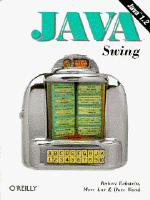Java Swing, by Eckstein, et al.With the introduction of the Swing graphical toolkit to Java 1.2, developers now have the freedom to write applications with rich graphical user interfaces (GUI). Swing gives Java applications the professional edge that has long been shared by their C++, VB & Delphi counterparts, and goes further with a huge range of new components and controls, and customizable "look-and-feels". But while Swing may be the way of the future for developers, its a steep learning curve because of the complexity of the Swing toolkit. That's where "Java Swing", published by O'Reilly, comes in. Java Swing, at a whopping 1200+ pages, is a fantastic reference that you'll keep within arms reach as you program in Swing. But the book is more than just an API reference - its a combined tutorial and book of examples. Aside from the first few chapters, which provide a basic grounding for the rest of the book, you can skip from chapter to chapter as your needs dictate. It covers all the major component groups, as well as providing useful examples and code snippets. My one complaint about this title is that it appears to have tried covered the entire swing library, and in doing so the authors tried to put just too many topics into it, at the expense of detail. Perhaps it needs to be split into two volumes, but in my programming I found that there were some areas where a more thorough treatment should have been given (in particular, the chapter on trees which provides not enough detail, and only very simple examples). That said, "Java Swing" is a fantastic resource, both as a reference and an overview/tutorial of Swing, and is the best Swing book available to-date (as of February 1999). |
Java Swing, Experience level : |
